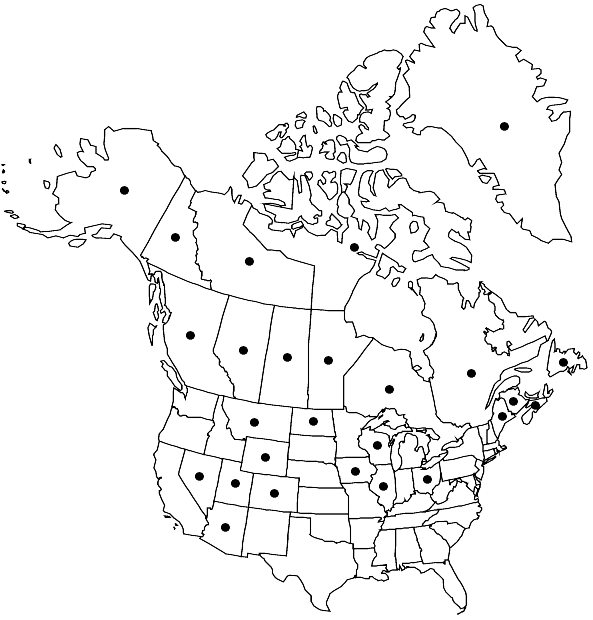Tortula cernua
Musc. Scand., 20. 1879,.
Leaves elliptic, apex broadly acute to rounded-acute, mucronate or apiculate, margins recurved at mid leaf, bordered throughout or in lower 2/3 with 2 (–3) rows of narrower, short to long-rectangular, thicker-walled cells that 1–2-stratose; costa percurrent or short-excurrent, lacking an adaxial pad of cells, distally narrow, 3–4 cells across the convex adaxial surface; distal laminal cells hexagonal to rectangular, (13–) 16–24 (–28) µm wide, 1–2: 1, not or rarely very weakly papillose. Sexual condition autoicous. Sporophytes exerted. Seta 0.6–1.2 cm. Capsule stegocarpic, not systylius, short-cylindric and curved or ovoid and bilaterally symmetrical, nodding or occasionally nearly horizontal, urn 1–1.8 mm; peristome weak, ca. 100–200 µm, teeth 16, not twisted, divided nearly to the base into 2–3 branches and variously perforate, basal membrane very low or absent, or rudimentary or fragmentary and attached to the inside of the operculum; operculum 0.2–1.5 mm. Spores 25–35 µm, spheric, densely papillose.
Phenology: Capsules mature summer.
Habitat: Soil, limestone
Elevation: low to moderate elevations
Distribution

Greenland, Alta., B.C., Man., N.B., Nfld. and Labr. (Nfld.), N.W.T., N.S., Nunavut, Ont., Que., Sask., Yukon, Alaska, Ariz., Colo., Ill., Iowa, Maine, Mont., Nev., N.Dak., Ohio, Utah, Wis., Wyo., Europe, Asia
Discussion
Tortula cernua differs from T. laureri in the usually smooth laminal cells, the mostly ovoid and bilaterally symmetrical capsule inclined to horizontal, and peristome not twisted. Its range is more southerly and at lower elevations. The small and fragile peristome commonly falls with the operculum, being attached to its inner surface, and the capsule may appear gymnostomous. Given that the uncommon T. randii is only distinguished from T. cernua by the apparent absence of a peristome and has much the same range, and all specimens of that species I have seen are indeed peristomate or, as in A. J. Grout, N. Amer. Musci Perf. 197, MO, have smooth fragments of a peristome attached to the inner surface of the operculum, I agree with J. M. Holzinger (1925) that it should not be recognized as distinct.
Selected References
None.
Lower Taxa
"um" is not declared as a valid unit of measurement for this property."um" is not declared as a valid unit of measurement for this property.